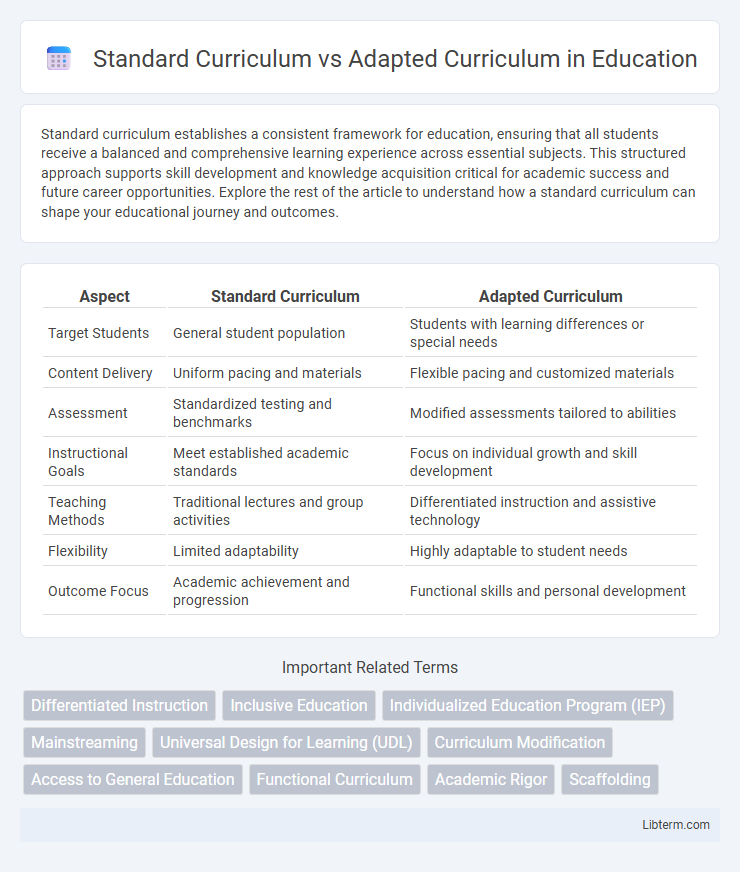Standard curriculum establishes a consistent framework for education, ensuring that all students receive a balanced and comprehensive learning experience across essential subjects. This structured approach supports skill development and knowledge acquisition critical for academic success and future career opportunities. Explore the rest of the article to understand how a standard curriculum can shape your educational journey and outcomes.
Table of Comparison
| Aspect | Standard Curriculum | Adapted Curriculum |
|---|---|---|
| Target Students | General student population | Students with learning differences or special needs |
| Content Delivery | Uniform pacing and materials | Flexible pacing and customized materials |
| Assessment | Standardized testing and benchmarks | Modified assessments tailored to abilities |
| Instructional Goals | Meet established academic standards | Focus on individual growth and skill development |
| Teaching Methods | Traditional lectures and group activities | Differentiated instruction and assistive technology |
| Flexibility | Limited adaptability | Highly adaptable to student needs |
| Outcome Focus | Academic achievement and progression | Functional skills and personal development |
Introduction to Standard and Adapted Curricula
Standard curriculum follows a fixed set of educational objectives and content designed to meet the general learning needs of a broad student population. Adapted curriculum modifies these objectives and materials to accommodate individual learners' diverse abilities, strengths, and challenges, ensuring accessibility and personalized growth. This differentiation supports inclusive education and maximizes student engagement and achievement.
Defining Standard Curriculum
Standard curriculum establishes a consistent framework of academic content, learning objectives, and assessment criteria designed for the general student population. It aligns with state or national education standards to ensure uniformity and comparability in educational outcomes across schools. This structured approach emphasizes grade-level benchmarks and facilitates standardized testing to measure student proficiency.
What is Adapted Curriculum?
Adapted Curriculum refers to a customized educational plan designed to meet the unique learning needs, abilities, and interests of students with disabilities or learning differences. It modifies the content, teaching methods, and assessment strategies to provide equitable access to the curriculum while maintaining alignment with core educational standards. This approach supports individualized learning goals and promotes inclusive education by accommodating diverse student profiles.
Key Differences Between Standard and Adapted Curricula
Standard curricula follow a fixed set of educational goals designed for the general student population, emphasizing uniform content and assessment methods. Adapted curricula customize learning objectives, materials, and teaching strategies to meet the diverse needs of individual students, particularly those with learning disabilities or special educational needs. Key differences include the level of flexibility, with adapted curricula allowing modifications in pace, content depth, and instructional techniques to enhance accessibility and comprehension.
Advantages of a Standard Curriculum
A Standard Curriculum provides a consistent framework that ensures all students acquire essential knowledge and skills aligned with national educational standards. This uniformity facilitates standardized assessments, making it easier to measure academic progress and maintain quality across different schools and regions. It also streamlines teacher training and resource development, promoting efficient implementation and minimizing educational disparities.
Benefits of an Adapted Curriculum
An adapted curriculum offers personalized learning experiences tailored to individual student needs, enhancing engagement and comprehension. It accommodates diverse learning styles and abilities, promoting inclusivity and equity in education. This approach fosters improved academic outcomes by addressing specific challenges and leveraging strengths unique to each learner.
Challenges in Implementing Adapted Curriculum
Implementing an adapted curriculum often faces challenges such as limited resources, insufficient teacher training, and resistance to change within educational institutions. Schools may struggle with balancing standardized testing requirements and individualized learning goals, leading to difficulties in assessing student progress effectively. Ensuring appropriate support for diverse learner needs requires continuous collaboration among educators, parents, and specialists, which can be time-consuming and complex to coordinate.
When to Choose Adapted Over Standard Curriculum
Choose an adapted curriculum when students have diverse learning needs, including disabilities, language barriers, or varying cognitive abilities that hinder progress in a standard curriculum. Adapted curricula provide personalized learning goals, modified content, and flexible pacing to accommodate individual strengths and challenges effectively. Selecting this approach ensures equitable access to education, fostering improved engagement and academic success for students requiring tailored instructional strategies.
Case Studies: Practical Applications
Case studies reveal that standard curricula often struggle to meet diverse learner needs, while adapted curricula demonstrate improved engagement and academic outcomes by tailoring content to individual abilities. Research indicates that adapted curricula in special education settings increase student retention rates by up to 30% compared to standard curricula. Practical applications in inclusive classrooms show that modifying instructional materials enhances comprehension and supports personalized learning goals effectively.
Conclusion: Selecting the Right Curriculum
Choosing the appropriate curriculum depends on the learner's unique needs, goals, and abilities, where the standard curriculum offers a structured, comprehensive approach for general education, while the adapted curriculum provides personalized modifications to support diverse learning challenges. Educators must assess individual student profiles, including cognitive levels and learning styles, to decide whether standard content mastery or tailored instructional strategies will yield optimal academic outcomes. Effective curriculum selection enhances engagement, maximizes skill development, and ensures meaningful progress aligned with educational standards and personal growth objectives.
Standard Curriculum Infographic

 libterm.com
libterm.com